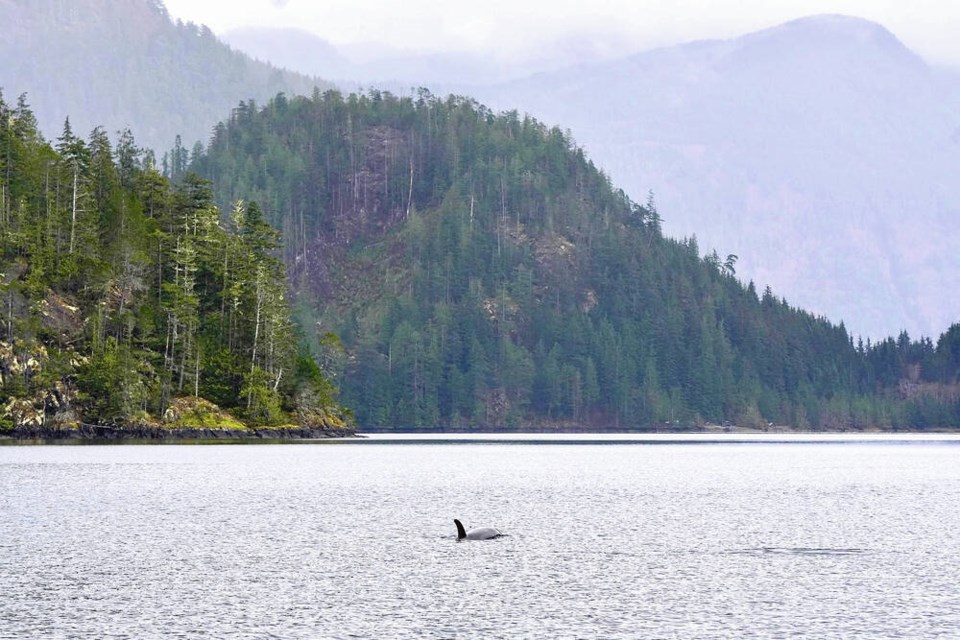A young orca stranded in a shallow lagoon at Zeballos for the past five days isn’t being fed by her rescuers, but still appears healthy, as scientists and First Nations consider all options to save her — including capturing and moving the calf.
Paul Cottrell, marine mammal co-ordinator with the Department of Fisheries and Oceans, said Wednesday that results of a necropsy on the two-year-old calf’s mother revealed she was still lactating and providing the calf with nourishment, “indicating the calf was particularly dependent on its mom.”
“We are thinking beyond if we have to change tactics, depending on the calf’s health going forward,” said Cottrell.
He didn’t rule out capturing the whale in a stretcher-like sling to move it closer to the family pod.
“We’re looking at all contingencies and contingencies later on,” said Cottrell. “As you can imagine, this is a very short time window we have, so we’re having to look at all those options and think ahead in case we have to look at those later options, which is in progress for sure.”
Cottrell estimated the calf could survive “a couple of weeks” without food, but wasn’t sure because of the calf’s young age. DFO drone footage shows the orca is active and “looks OK,” he said.
Cottrell said rescuers are also considering having seal meat at the ready to feed the calf or as an enticement to move it out of the lagoon and through a narrow channel into open water.
The 120-foot-opening, under a roadway span, and the changing tides that rush through it are proving to be a barrier in leading the calf out.
Ehattesaht/Chinehkint First Nation Chief Simon John said getting the calf through the opening “is like threading a needle.”
“We are taking a little break today,” said John, adding the team, which includes scientists and members of area First Nations, is determining what to do next.
The whale’s 15-year-old mother drowned on Saturday after becoming beached on her side on a gravel bar in Little Espinosa Inlet.
John said it was thought she became beached Friday night and spent hours trying to free herself. The orca died about 10:30 a.m. Saturday, despite efforts from community members to roll her onto her belly so her blow hole was free for breathing as the tide came in.
A necropsy revealed the orca was carrying an unborn fetus, and Cottrell said that might have made rolling her difficult. The mother orca is estimated to have weighed between eight and 10 tonnes.
Cottrell said scientists have been using recorded vocalizations from members of relative orca pods to try to coax the calf out of the lagoon. They also tried banging metal pipes together and lengths of loose ropes attached to buoys to corral it toward the opening. None have been successful.
John said the worry about attempting to feed the young calf is it might become habituated to humans. This week, John said the story of Luna, another young killer whale who showed up in nearby Nootka Sound and became attracted to boats and human contact, was on his mind. Luna spent five years in the area, rubbing boats and allowing human petting before it was killed by a tug propeller in 2006.
John said he expects rescue team members will resume their efforts today to help the calf into the open ocean, where it’s hoped it will reunite with family members.
“My real concern is getting this little calf out of the lagoon safely,” said John.
The Ehattesaht/Chinehkint and Nuchatlaht First Nations have given the young orca a name: kʷiisaḥiʔis (kwee-sahay-is), which means Brave Little Hunter.
Cottrell and John said whale-watching companies, private boaters and scientists are looking for orca pods in the area, with recent sightings of possible relative families off the coast reported to the rescuers.
Cottrell said a potential family pod was spotted at Ahousaht, near Tofino, moving north on Wednesday.
“We have to have a lot of things that have to work just right” for a reunification, he said.
“I’ve been involved in a lot of marine mammal rescues, but this is the most complex so far. It’s a very difficult situation for all involved, and we want the best outcome for the calf.”
In a social media post on Wednesday, Bay Cetology, which has scientists involved in the rescue, said: “Despite our best approaches, the little one has shown us it is not ready to go.”
“After a long discussion with Ehattesaht and Nuchatlaht First Nations and DFO, the collective approach for now is to grieve with the little one and circle back with fresh ideas and spirit soon. No one is about to give up on kʷiisaḥiʔis (Brave Little Hunter) a.k.a. T109A3A.”



